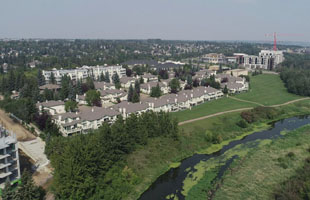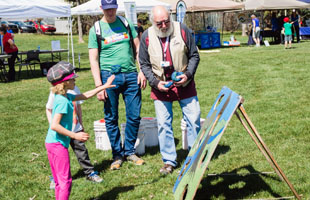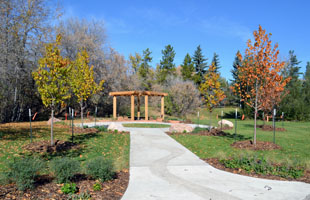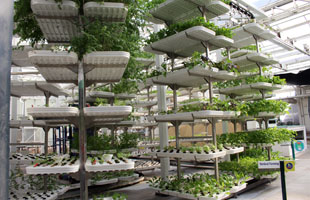Drivers of Change
Affecting how the city will grow
This is a time of dramatic change in St. Albert, Canada, and the world. The drivers listed below are some of the most important considerations St. Albert faces today and will continue to face in the future. They are wide-ranging in nature and affect all aspects of how the city will grow and change over time.
Climate Change
Extreme weather events frequently result in the loss of property and lives and have major impacts on a city’s infrastructure, services, and economy. Like all cities, St. Albert needs to adapt to climate change impacts to ensure its infrastructure is resilient and its facilities and services are prepared when extreme events occur. Cities and their citizens also need to mitigate and reduce climate change impacts and human contributions, in particular by adopting renewable energy resources, ensuring buildings are energy efficient, embracing low-impact development practices, and reducing reliance on private vehicles.
Photo: Kim Hamson
Economic Diversification
A variety of factors have contributed to ongoing economic uncertainty around the world, including the impact of COVID-19, rapid advances in technology, climate change, and the ups and downs of globalization. Federal, provincial, and municipal governments are continuing the push to diversify Alberta’s economy by attracting new businesses, and industry is developing new products, services, and markets to enable their long-term success. Cities play a vital role in supporting economic growth and diversification as hubs for education, research and development, manufacturing, and international trade. St. Albert can build on its many assets to become an innovation and economic hub within the region.
Photo: Michael Rivera (Creative Commons: CC BY-SA 4.0)

Linking Public Health to the Built Environment
In Alberta, rates of obesity and diabetes are increasing, and a range of societal and personal issues are increasing the demand for mental health services. Cities have long supported good public health by providing a range of recreational and cultural services. Policymakers and public health professionals now recognize that how we plan and design our cities is also strongly linked to public health. For example, compact, complete communities with interconnected street and trail networks encourage walking and cycling, both of which have physical and mental health benefits.

Emerging Technologies
Municipal governments recognize the opportunity to make better use of new technologies for operational efficiencies and improved service delivery. “Smart cities” use advances in data gathering, analysis, and transmission, including artificial intelligence, to respond more quickly and effectively to issues that arise in the community and to predict future needs. Over time, autonomous vehicles are expected to fundamentally change how people move around, reducing the need for private vehicles and transforming public transit.
Photo: Grendelkhan (Creative Commons: CC BY-SA 4.0)

Affordable Housing
The cost of housing affects low-income and middle-income urban households. With an increasing number of households forced to spend more than 30% of their income on housing costs, it is difficult to afford other necessities. Overspending on housing also leads to ongoing housing instability, which may in turn lead to homelessness. St. Albert’s median housing prices and rents are some of the highest in the Edmonton region. With aging citizens and younger residents struggling to afford their own homes, St. Albert needs to address housing affordability to ensure a high quality of life and economic growth. A diverse mix of new housing choices is an essential part of the solution. Strategic intensification and the convenient location of services, amenities, and transit, in proximity to housing, will also help.

Aging Society
As baby boomers move into their retirement years, and with many of them expected to live well into their eighties and nineties, cities need to grow and adapt to meet their needs. Many people in this age cohort want to downsize to affordable smaller homes within their neighbourhoods. With more leisure time, seniors are using recreational and cultural facilities more frequently. As they age, many will stop driving and rely on transit services or other modes of travel instead. As cities address the needs of an aging population, they also need to attract young and middle-aged adults who provide a skilled workforce that contributes to the economy and tax base.

Migration
New Canadians will fuel much of St. Albert’s future growth. New Canadians will help our city flourish, supporting population and economic growth and enriching cultural diversity. To attract new Canadians, the city needs a range of job opportunities and a variety of housing choices. Transit service may see increased demand, and municipal services need to respond to the needs of newcomers, for example, by adding recreation facilities and gathering spaces that reflect changing demographics.

Truth and Reconciliation
The Truth and Reconciliation Commission of Canada examined the traumatic impact of residential schools on generations of Indigenous families and explored ways for Canadians to support the healing process. As part of its mandate, the Truth and Reconciliation Commission of Canada identified actions that municipalities can take to further the work of reconciliation. Reconciliation refers to the efforts we take to increase understanding and restore balanced relationships among Indigenous and non-Indigenous people. At the municipal level, planning has an important role to play by providing a connection between people, land, and government. As part of St. Albert’s reconciliation journey, planning policies and processes can help support the healing process.
- - - - -
Previous:
Edmonton Metropolitan Region Growth Plan
Last edited: June 2, 2021


